| |
|
St Peter,
Weasenham
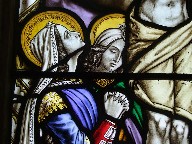 |
|
St
Peter sits hard against the busy Swaffham to
Cromer road, a landmark site for a thousand years
or more. It marks the northern end of Weasenham,
a large, straggling village divided into two
parishes, and there is another medieval church at
the southern end of the village in a slightly
more secluded setting. In days gone by, Weasenham
St Peter was known as Lower Weasenham. Both
Weasenham churches were considerably rebuilt. All
Saints, at the other end of the village, was
reconstructed in 1905, but St Peter underwent the
privilege thirty years earlier. There is a
photograph of the church on display inside which
shows it on the eve of its restoration, and in
all honesty it is hard to see much externally
which survived from that time. Even the flushwork
was reset and made crisp. The path to
the church climbs steeply from the busy road. For
many years, this church was kept locked against
visitors, but today it is open every day, and you
let yourself in through the north porch into a
warm, moderised interior.
|
Just as
Weasenham All Saints up the road was rebuilt for Low
Church congregational worship, so this place celebrated
the Anglo-catholic tradition, and to an extent continues
to do so. And, just as the other church has one great
medieval survival in the form of its rood screen, so St
Peter has its own survivals in the form of 15th Century
glass. There is a beautiful figure of St Margaret
dispatching her dragon, and in the next window a Norwich
school angel. They were both originally set in upper
window lights, and are now surrounded by fragments of
contemporary tabernacle work. There is no way of knowing,
of course, if they came from this church originally.
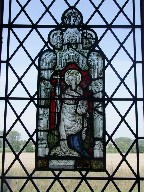
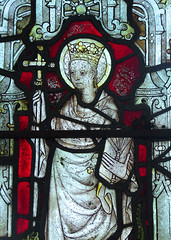 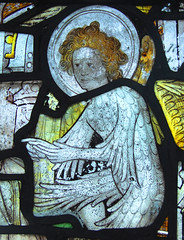 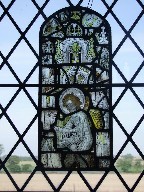
Turning to
the east, you meet the delight of a splendid window by
William Warrington. It commemorates someone who died in
1849, but can it really be that early? It is full of
exuberant colour and details, and if the date is right
then it preempts much of the enthusiasms of the
mid-century Ecclesiological Movement. The central subject
is a crucifixion, the Blessed Virgin, Mary Salome and St
John looking on grief-stricken and Mary Magdalene burying
her face in her hands. The same figure of Mary Magdalene
appears to the left, an unusual scene of her pouring oil
onto Christ's feet while a po-faced Judas looks on. On
the right, rather more awkwardly, Christ welcomes the
children. Above, St Peter and St Paul in sentry box-like
tabernacles look up to the Blessed Virgin and Child. it
is remarkably early work for such Anglo-catholic themes
in early Norfolk. Above, there are angels and a shield of
the Holy Trinity. I think this window is really rather
wonderful, and appears little-known.
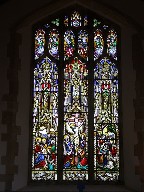 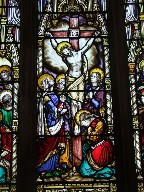 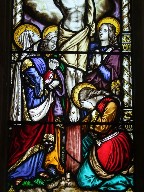 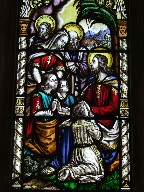 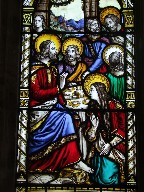 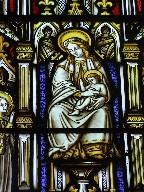
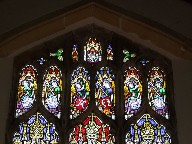 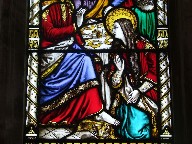 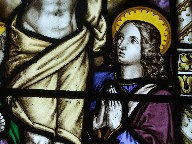 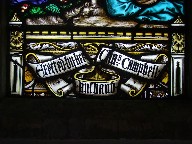
Any doubts
as to the Anglo-catholic sympathies here in the mid-20th
Century may be allayed by stepping through the curtain
that divides the south aisle from the nave. Here, the
east window is another splendid creation, this time by
Christopher Webb I think, depicting St George and St
Michael flanking the Blessed Virgin and Child. Below is a
deliciously carved and painted altar with figures
representing the Annunciation, the Crucifixion and the
Resurrection. Could it have been carved locally?
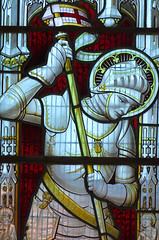 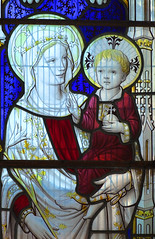 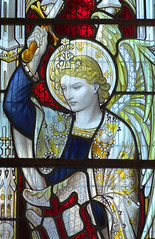
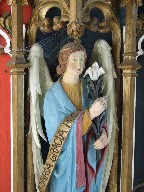 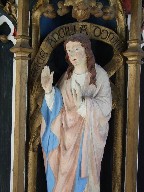 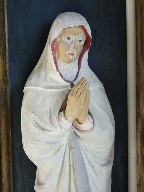 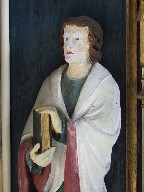 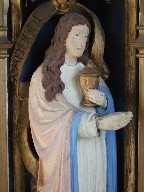 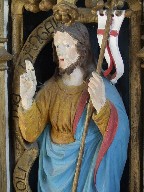
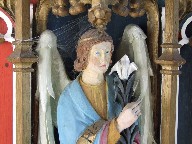 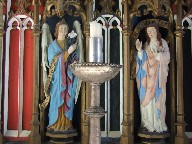
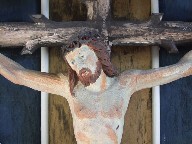
I was so
pleased I'd seen inside and it was so lovely. For years,
the Weasenham churches were a little black spot in this
area of Norfolk where pretty much all the churches are
open and welcoming, and being so close to the main road
it would be nice to think that they will be able to
attract visitors in the way that Newton by Castle Acre
does on the same road a few miles to the south.
| This
church, full of light and colour, is a complete
contrast with its neighbour up the road, but both
are fine buildings, and both welcoming. St Peter
has the edge in survivals, because it also
retains its original font, which I think is late
14th Century, its bowls decorated with
quatrefoils. Someone has later carved 1607 into
the south face, too neatly to be vandalism, I
think. Could it mark the date the font was
brought here from somewhere else? Bill Wilson in
the revised Pevsner notes that the church was
criticised for being excedinglie decaied by
the Necligence of the Propietaine in 1602,
so perhaps there was a considerable restoration
at that time. An intriguing thought, because this
would be too early for Laudian sacramentalism to
have any influence. I wandered
around to the south side of the church, where the
graveyard is wide and open. Here is an excellent
collection of high quality headstones of the late
18th and 19th Centuries, the funerary symbolism
including weeping willows, draped urns, figures
of grief, coronets, rayed books, cherubs, and the
stark reminder that the Mortal must put on
Immortality. Many are to members of the
Billing family, who were obviously a prosperous
lot. And yet, by the time of White's Directory of
Norfolk in 1845, they had all gone, and indeed it
is striking that both Weasenham churches are
relatively bereft of memorials. White does record
the intriguing detail, however, that in the reign
of Edward III, Sir John de Wesenham of this
parish was the king's butler. Being a rich
merchant in the City of London, he had the
king's crown in pawn for money advanced for the
wars in France.
|
|
 |
|
|
|
